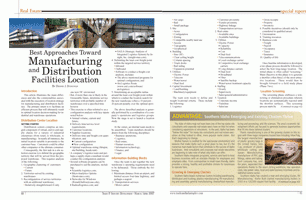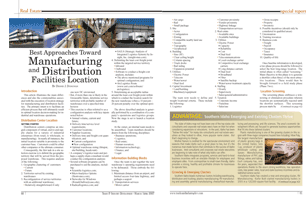
 Introduction
Introduction
This article illustrates the main differences and also the commonalities associated with the execution of location strategy for manufacturing and distribution facilities. The primary intent is to facilitate an efficient process that will ultimately result in optimal location decision-making for industrial and warehouse operations.
Distribution Center Location
Getting Started
Distribution centers comprise an integral component of virtual, end-to-end supply chains for a variety of industrial enterprises (from retail, to wholesale, to manufacturing). In nearly all instances, the initial location variable is proximity to the customer base. Customers could be either other companies or the ultimate consumer.
Consequently, the first task in a site selection exercise is to delimit the geographic territory that will be served from the proposed warehouse. This requires analysis of the following
1. Geographic clustering of customers
Current
Future
2. Territories served by existing warehouses
3. Reconfiguration of service territories with an additional warehouse
Relatively straightforward if only one new DC envisioned. But, if more than one is likely in the foreseeable future , determine service territories with probable number of warehouses over a specified time horizon. This exercise is often referred to as a configuration analysis with key inputs noted below:
Annual volume, current and future
Delivery time/service level requirements
Customer locations
Supplier locations
Delivery time and freight cost quantification
Current configuration
New configuration
Optimal warehouse sizing (thruput, site/building, headcount)
A company’s logistics team and perhaps a supply chain consultant would conduct the configuration analysis
Several software programs can be purchased to aid the analysis, including
Scientific-logistics.com
MicroAnalytics Optisite (Bestroutes.com)
Networks for Windows (Ronald.ballou@case.edu)
Radicallogistics.com
SAILS (Strategic Analysis of Integrated Logistics System) by Insight, Inc. (insight-mss.com)
4. Delimiting the least cost freight point within the targeted service territory
Inbound
Outbound
Software to conduct a freight cost analysis, includes
The above mentioned programs for optimal configuration
ArcLogistics Route (www.esri.com/software/arclogistics)
5. Determining an acceptable radius around the least cost freight point within which to conduct the location search for the new warehouse (often a 10%-20% penalty over the optimal spot)
The above described analysis is generally performed by a coordination of a company’s operations and logistics groups. Now the stage is set to launch a location study.
At the outset, an internal team needs to be assembled. Team members should be drawn from the following disciplines:
Business operations
Logistics
Real estate
Human resources
Information technology
Finance
Legal
Information Building Blocks
Once the team is put together the new warehouse’s operating requirements need to be delineated. Those embody the following:
1. Maximum distance from an airport, and limited access four-lane highway, and perhaps a seaport
2. Transportation services
Motor carriers
Air cargo
Rail
Small package
3. Site
Acres
Configuration
Zoning
Compatible nearby land use
Access
Topography
Geophysical
4. Building
Size (SF)
Clear ceiling height
Column spacing
Truck docks
Rail siding
Expansion potential
5. Utilities
Electric Power
Telecom
Water/sewer
Dual feed
6. Capital Investment
Land/building
Machinery/equipment
The team now needs to define and weight locational criteria. These include the following:
1. Logistics
Customer proximity
Vendor proximity
Highway linkage
Transportation services
2. Real estate
Available sites
Available buildings
3. Utilities
Electric Power
Capacity
Reliability
Cost
Dual feed
Telecommunications
Local exchange carrier
Competitive local exchange carriers
Long distance carriers
Dual feed
Broadband
Fiber
Satellite backup
Water/sewer treatment capacity
4. Staffing
Hourly
Supervisory
Sales/general/administrative
5. Taxation
Corporate income
Franchise
Sales/use
Gross receipts
Property
Inventory
6. Possible incentives (should only be considered in qualified areas)
7. Unionization
8. Training resources
9. Business costs
Freight
Payroll
Occupancy
Taxes
Insurance
10. Quality-of-life
Once baseline information is developed, a two phase process should be followed to select the best long-range location. The initial phase is often called “screening.” Main objective in this phase is to generate a shortlist (often three) of the most attractive locations. These would then be brought forward to a field study phase (Phase Two).
Location Screening
The screening phase embraces a winnowing or elimination procedure wherein locations are systematically rejected until the shortlist surfaces. This screening process starts by rejecting obviously unacceptable areas in the search region. Illustrative early stage elimination factors for distribution centers often include:
Distance from a limited access four-lane highway
Class I railroad service
Minimum population size
Distance from seaport
Distance from a commercial airport
An iterative process should now be followed wherein increasingly more restrictive criteria are introduced until a longlist (possibly 10) of promising areas emerges. Examples of middle stage screening factors include:
Population trends
Labor force trends
Highway linkage
Inventory tax
Wholesale trade average salaries
Once the longlist has been generated, the team will reach out to state and/or local economic development agencies to obtain information that provides a better understanding of local operating conditions. It is therefore important to obtain information such as:
Site/building availability
Construction costs
Land costs
Electric power costs
Utility service
Local wage surveys (e.g., warehouse worker, picker/packer, material handler)
Competitive employers (distribution and manufacturing)
New/expanding blue collar employers
Downsizing blue collar employers
Motor carriers with local terminals
Truckload (TL)
Less than truckload (LTL)
Rail service
Small package service
Freeport legislation if inventory tax exists
Potential incentives
At this point the semifinalist (or longlist) areas should be ranked/scored. The purpose is to pinpoint three finalists (shortlist). Semifinalist areas should be ranked/scored on individual factors aggregated into broad categories such as:
Marker/supplier proximity
Transportation resources
Labor market
Real estate
Business cost
Quality-of-life
Composite
Field Assessment
Once a shortlist (maybe three locations) has been identified, the team needs to conduct a first-hand evaluation in each area (Phase Two). This field-based due diligence assessment should entail the following.
1. Orientation to the area by the lead economic development agency
2. Tours of potentially suitable sites
3. Interviews with comparable employers
4. Interviews with other entities, such as
Transportation
Utility representatives
Government officials
Field study results should be analyzed to compare finalist locations and determine which one is most ideally suited for the proposed distribution center. Essentials for the comparative assessment include:
Market/supplier areas
Transportation resources
Labor market
Sites/buildings
Business cost
Incentives
Business regulation
Training
Quality-of-life
Leadership attitude
For distributors serving a highly localized market (e.g., single metro area) delivery times and costs can vary from one site to another. Hence, many of these firms will perform a route optimization analysis to determine which potential site is best from a customer delivery/time cost standpoint. Several software programs can be valuable tools for such an analysis. These include:
ArcLogistics (www.esri.com/software/arclogistics)
Maptuit.com
Mile.com
Once the above defined study is completed the preferred location and best alternative would be chosen. Now it is time to undertake final real estate and incentives negotiations in each area. Unless these negotiations yield meaningful differences, the top (preferred) location should be selected for the new distribution center.
Additional Thoughts
It should also be stressed that distribution centers, unlike most factories, require large floor plates and high ceilings. Structures often occupied by distributors are sometimes referred to as “big boxes.” They can easily be one million SF with 35 ft. ceilings and sit on a 125+ acre site. A significant number of distribution centers, especially in the perishable goods sector, require buildings arranged for cross-docking. The term reflects a building design allowing goods to be received at one truck door and shipped out another door, almost immediately, without putting the merchandise in storage. Cross-docking can be done through doors either at tailgate or drive-in height.
Before leaving our discussion on warehousing it is instructive to mention another discernable trend that we see accelerating over the next few years. That is the tactical decision of many warehousers to site new facilities in small towns. Usually, these communities will be within hailing distance (maybe 2 hours) of a large metro area featuring a dense concentration of warehouse operations. While many companies must be situated in a large metro (e.g., customer access) others have more leeway. That is they can withstand extra transportation costs and delivery times to enter far less expensive smaller areas. These areas yield substantial labor cost savings and secondarily lower real estate cost and taxes. Incentives are also usually greater. And the warehouse will likely be considered an “employer-of-choice”, enhancing recruitment/retention of qualified workers. Examples of DCs that have been established in smaller towns include the following:
Dollar Tree Marietta, (OK)
Ikea, Danville (VA)
Target, Liberty County (GA)
Wal-Mart, North Platte (NE)
Harbor Freight Tools, Dillon (SC)
Manufacturing Location Selection
Mobility Constraints
Some manufacturing entities will be geographically limited in location options due to customer imposed demands for proximity. For such businesses, their location strategy is largely shaped by JIT (just-in-time) demands placed on them by customers. Hence, the geographic search territory can be as narrow as the same community or as wide as next day delivery by truck (often 450 miles). Such “local” industries often include auto parts, aerospace contractors, bakeries, beverages, building materials, intermediate chemicals, and packaging.
Manufacturers encountering geographic constraints should nevertheless follow the two phase process denoted above to choose a location whose attributes will maximize success of the new enterprise. Again, the two phases are screening (getting to a shortlist of the most attractive locations) and field-based due diligence to select the best long-range location.
Many other industrial operations have much greater geographic mobility. Frequently these companies can consider multiple regions or even an entire country. Typically, these firms produce light weight and high value products. Examples include electronics, instruments, industrial equipment, medical equipment, pharmaceuticals, and health/beauty products. Like their geographically limited brethren, these highly mobile companies also need to follow a structured, two phase analytical process (screening and field study) to arrive at an optimal location decision.
Reaching the Shortlist
Once the manufacturing site selection team has defined year one/future operating requirements (e.g., staffing, site/building, utilities, transportation, etc.) and concurred on weighting of various locational criteria, the screening exercise (Phase One) can begin. Among the most important factors that manufacturers often utilize to eventually create a shortlist (typically three) of viable locations are:
1. Distance from a limited access four-lane highway
2. Distance from a commercial airport
3. For about 10%-15% of manufacturers, rail service availability
4. Natural disaster risk (e.g., earthquakes)
5. Geographical balance in the supply chain (e.g., distance among various plants in the company’s real estate portfolio)
6. Manufacturing industry concentration (too much above the national average of 13% could signal stiff labor market competition)
7. Distance from key suppliers which could include a seaport for imported goods
8. Average manufacturing industry wages
9. Employment in pertinent occupations (e.g., machine operators)
10. Electric power costs
11. Electric power transmission congestion
12. Natural gas availability
13. Water supply
14. Air quality attainment
15. Industrial building construction costs
16. Demographic trends
These and other factors utilized in the screening process will result in a longlist (maybe 10) of promising areas. There are a number of good data sources that can be tapped for this desktop research. Examples are furnished in Table 1.
At this point (after desktop research) contacting state/local economic development agencies to gain a better understanding of potential business operating conditions comprises the next task. Emblematic of variables that should be addressed to distinguish and rank the longlist are:
Major employers (mainly for labor market compatibility)
All sectors
Manufacturing
Distribution
New/expanding employers (a harbinger of near-term labor market competition)
Downsizing industrial companies (temporary, supplemental labor pool)
Post secondary training programs
Unionization
Organized companies
Organizing activity
Right-to-Work legislation
Transportation services
Available buildings
Available fully serviced sites
Site/building costs
Utility infrastructure
Electric power
Supply
Reliability
Cost
Natural gas
Availability
Cost
Water/sewer treatment
Capacity
Cost
Telecom capabilities
Environmental regulation, including hazardous waste
Distance to hazardous waste sites
Potential users of scrap
Number of vendors within a reasonable distance
Tax practices/rates
Potential incentives
Quality-of-life characteristics
Predicated on these and other appropriate considerations, longlisted areas need to be ranked/scored. The top rated locations (perhaps three) will then make-up the shortlist (finalist areas) to be comprehensively assessed in Phase Two.
Final Evaluation
As for distribution centers, manufacturing site selection teams need to visit each area for Phase Two evaluation. In this phase, the following is essential:
Get acquainted with the area by attending an orientation session held by the lead economic development group
Tour, inspect, and shortlist sites/buildings submitted by the economic development group
Interview comparable firms to learn of their recent operational experiences and opinions on future conditions
Interview other entities that can shed light on the business operation environment, e.g.,
State Chamber of Commerce (regulation/business climate)
Local government officials
Tax assessors
Transportation representatives
Property owners/developers
Education/training representatives
State labor office
Personnel agency
Environmental regulators
Local business associations
Potential suppliers (e.g., machine shop)
Request the lead economic development organization to submit a preliminary incentives package including the following:
Succinct program description
Eligibility requirements
Restrictions
Clawback/recapture provisions
Estimated savings
Collect and analyze field study results. Where needed, ask the lead economic development entity for more specific information (e.g., electric power reliability in circuits of substations servicing targeted sites). Then rank/score each area, concentrating on factors that are of greatest importance to the business. The comparative ranking should include:
1. Labor market
2. Transportation
3. Sites/buildings
4. Utilities
5. Environmental
6. Permit approval time
7. Taxation
8. Quality-of-life
9. State issues (e.g., tort/legal liability)
10. Multi-year business cost projections (with and without incentives)
Payroll
Occupancy
Transportation
Utilities
Taxes
Incentives (offset)
Once the top rated and best alternative locations have been agreed to (by the site selection team and executive management) the next tasks are to conduct final real estate and incentives negotiation in both locations as well as final due diligence in other arenas (e.g., tax, legal, environmental). Generally speaking, unless an unexpected dealmaker or breaker surfaces, the number one ranked location should become the ultimate winner.

